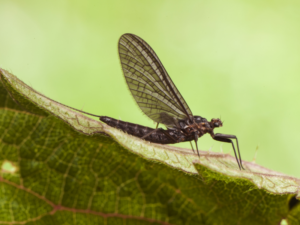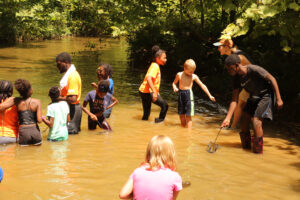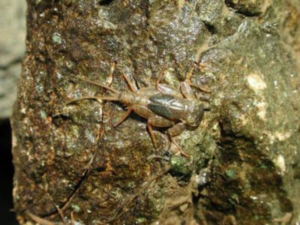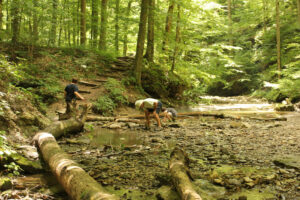By Olivia Belk
 At Bernheim, we pride ourselves on providing opportunities to connect people with nature, and what better way to do just that than bringing a pack of children to dive (sometimes literally) into a gorgeous creek? One of the field trip options we offer is a journey to the backside of Bernheim where children can become completely immersed in a rarely seen portion of the forest: a section of Wilson Creek. Here, we find fossils, an overabundance of crayfish, the occasional snake, and a wonderful way to cool off during stifling summer months.
At Bernheim, we pride ourselves on providing opportunities to connect people with nature, and what better way to do just that than bringing a pack of children to dive (sometimes literally) into a gorgeous creek? One of the field trip options we offer is a journey to the backside of Bernheim where children can become completely immersed in a rarely seen portion of the forest: a section of Wilson Creek. Here, we find fossils, an overabundance of crayfish, the occasional snake, and a wonderful way to cool off during stifling summer months.
 But this adventure is not strictly for fun, though we always have plenty of it. Back when Bernheim originally obtained the land, this creek was completely straight. It is believed it had been straightened by farmers who owned the land in the past to make more room for crops, and it basically served as a drainage ditch. In 2003, a collection of researchers, engineers, and Bernheim staff restored the creek to its natural meander and planted a variety of native species, turning this once degraded stream channel into a thriving habitat. Because of this work, Wilson Creek is an excellent place to study the environmental functions of a healthy stream and how biodiversity can be indicative of stream health. As a group, we search the undersides of rocks for a variety of wriggling creatures, as the presence of certain species indicates pollution free waters.
But this adventure is not strictly for fun, though we always have plenty of it. Back when Bernheim originally obtained the land, this creek was completely straight. It is believed it had been straightened by farmers who owned the land in the past to make more room for crops, and it basically served as a drainage ditch. In 2003, a collection of researchers, engineers, and Bernheim staff restored the creek to its natural meander and planted a variety of native species, turning this once degraded stream channel into a thriving habitat. Because of this work, Wilson Creek is an excellent place to study the environmental functions of a healthy stream and how biodiversity can be indicative of stream health. As a group, we search the undersides of rocks for a variety of wriggling creatures, as the presence of certain species indicates pollution free waters.

One of the creatures we search for is the simple mayfly, specifically the aquatic naiad form. A vast number of insects do not start their lives flying, instead spending more time buried in the dirt or underwater than they do above ground. The mayfly spends up to a couple years in this naiad form, where it scurries across the bottoms of rocks using its chewing mouthparts to feed on algae, plants, and tiny invertebrates. They possess tiny gills under their abdomens and three hair like tails, which is how one differentiates them from the very similar looking stonefly.
The reason we search for the mayfly specifically is that it has an extremely low tolerance for pollution and can only be found in clean waters, making them what we call an indicator species. Finding mayflies, along with a variety of other invertebrates, means the Wilson Creek restoration project was successful, as the water quality is now high enough to support these sensitive creatures. Field trips like this are an excellent way to get children out having adventures in nature while also learning about one of the exciting ways ecologists can determine habitat health.
Though we search for the naiad form of the mayfly at Wilson Creek, it is the adult form that is possibly most interesting. After they spend the majority of their lives underwater, the naiads crawl onto shore to molt into a full-grown adult, wings and all. They then take to the sky in droves to fulfill their single purpose as adults: reproduction. In fact, they do not even have mouth parts, as they’ve done all the eating they’ll ever do while naiads. Mayflies only live a couple days once adults, and some species live a short few hours. This is where the name of their order, Ephemeroptera, or “ephemeral wing”, comes from.
Some places will have so many mayflies that they appear as clouds in the sky, with masses of them mating, laying eggs, and dying within a couple of days or hours. But this window of time is an absolute boon to many of the other creatures around, who feast on the swarms. Birds swoop from the skies, while fish wait for those misfortunate mayflies who land on the water’s surface. Humans benefit as well, as avid anglers can be guaranteed increased success if they cast their lines beneath the mating mayfly clouds.
 These little insects are just one of many who can be found hidden beneath the waters at Bernheim. While Wilson Creek is inaccessible to visitors, Rock Run Trail is an excellent place to search for aquatic life. Head down to the stream bed and cool off by gently flipping over some rocks. Search the undersides for the round water penny beetle, the rocky construction of a caddisfly larva, or the prehistoric looking stonefly larva. And should you happen upon one of the ephemeral mayflies, know you have stumbled upon a creature whose tiny presence is significant in more ways than one.
These little insects are just one of many who can be found hidden beneath the waters at Bernheim. While Wilson Creek is inaccessible to visitors, Rock Run Trail is an excellent place to search for aquatic life. Head down to the stream bed and cool off by gently flipping over some rocks. Search the undersides for the round water penny beetle, the rocky construction of a caddisfly larva, or the prehistoric looking stonefly larva. And should you happen upon one of the ephemeral mayflies, know you have stumbled upon a creature whose tiny presence is significant in more ways than one.

